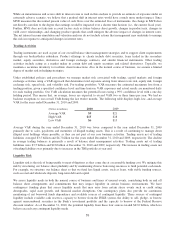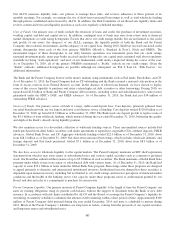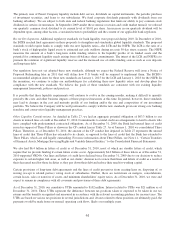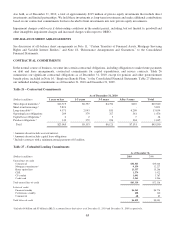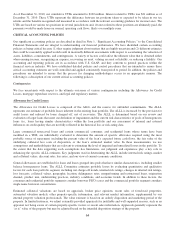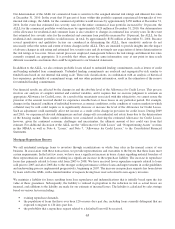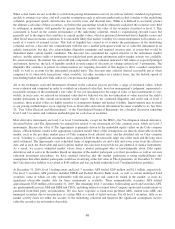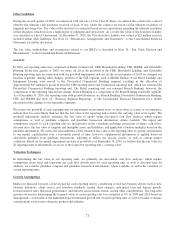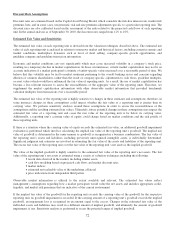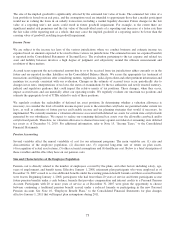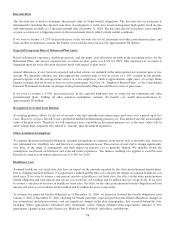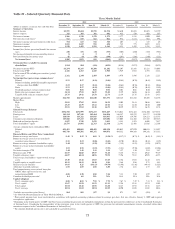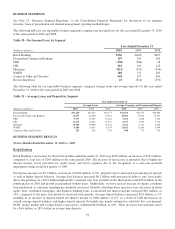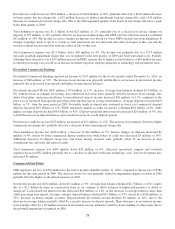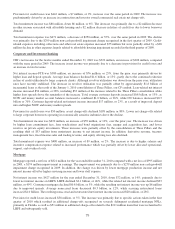SunTrust 2010 Annual Report Download - page 85
Download and view the complete annual report
Please find page 85 of the 2010 SunTrust annual report below. You can navigate through the pages in the report by either clicking on the pages listed below, or by using the keyword search tool below to find specific information within the annual report.When actual trades are not available to corroborate pricing information received, we will use industry standard or proprietary
models to estimate fair value, and will consider assumptions such as relevant market indices that correlate to the underlying
collateral, prepayment speeds, default rates, loss severity rates, and discount rates. While it is difficult to accurately predict
the ultimate cash value of these securities, we believe the amount that would be ultimately realized if the securities were held
to settlement or maturity will generally be greater than the current fair value of the securities classified as level 3. This
assessment is based on the current performance of the underlying collateral, which is experiencing elevated losses but
generally not to the degree that correlates to current market values, which is pressured downward due to liquidity issues and
other broad macroeconomic conditions. It is reasonably likely that market volatility for certain instruments will continue as a
result of a variety of external factors. This lack of liquidity has caused us to evaluate the performance of the underlying
collateral and use a discount rate commensurate with the rate a market participant would use to value the instrument in an
orderly transaction, but that also acknowledges illiquidity premiums and required investor rates of return that would be
demanded under current market conditions. The discount rate considered the capital structure of the instrument, market
indices, and the relative yields of instruments for which third party pricing information and/or market activity was available.
In certain instances, the interest rate and credit risk components of the valuation indicated a full return of expected principal
and interest; however, the lack of liquidity resulted in wide ranges of discounts in valuing certain level 3 instruments. The
illiquidity that continues to persist in certain markets are requiring discounts of this degree to drive a market competitive
yield, as well as account for the anticipated extended tenor. The discount rates selected derived reasonable prices when
compared to (i) observable transactions, when available, (ii) other securities on a relative basis, (iii) the bid/ask spread of
non-binding broker indicative bids and/or (iv) our professional judgment.
All of the techniques used and information obtained in the valuation process provides a range of estimated values, which
were evaluated and compared in order to establish an estimated value that, based on management’s judgment, represented a
reasonable estimate of the instrument’s fair value. It was not uncommon for the range of value of these instruments to vary
widely; in such cases, we selected an estimated value that we believed was the best indication of value based on the yield a
market participant in this current environment would expect. Due to the continued illiquidity and credit risk of level 3
securities, these market values are highly sensitive to assumption changes and market volatility. Improvements may be made
to our pricing methodologies on an ongoing basis as observable and relevant information becomes available to us. See Note
20, “Fair Value Election and Measurement,” to the Consolidated Financial Statements for a detailed discussion regarding
level 2 and 3 securities and valuation methodologies for each class of securities.
Most derivative instruments are level 1 or level 2 instruments, except for the IRLCs, the Visa litigation related derivative,
discussed below, and The Agreements we entered into related to our investment in Coke common stock, which are level 3
instruments. Because the value of The Agreements is primarily driven by the embedded equity collars on the Coke common
shares, a Black-Scholes model is the appropriate valuation model. Most of the assumptions are directly observable from the
market, such as the per share market price of Coke common stock, interest rates, and the dividend rate on Coke common
stock. Volatility is a significant assumption and is impacted both by the unusually large size of the trade and the long tenor
until settlement. The Agreements carry scheduled terms of approximately six and a half and seven years from the effective
date, and as such, the observable and active options market on Coke does not provide for any identical or similar instruments.
As a result, we receive estimated market values from a market participant who is knowledgeable about Coke equity
derivatives and is active in the market. Based on inquiries of the market participant as to their procedures as well as our own
valuation assessment procedures, we have satisfied ourselves that the market participant is using methodologies and
assumptions that other market participants would use in arriving at the fair value of The Agreements. At December 31, 2010,
the Coke derivative liability was valued at $145 million and was included within the level 3 trading liabilities portfolio.
At December 31, 2010, level 3 trading assets and level 3 securities AFS totaled $209 million and $1.1 billion, respectively.
Our level 3 securities AFS portfolio included FHLB and Federal Reserve Bank stock, as well as certain municipal bond
securities, some of which are only redeemable with the issuer at par and cannot be traded in the market; as such, no
significant observable market data for these instruments is available. These nonmarketable securities AFS totaled
approximately $728 million at December 31, 2010. The remaining level 3 securities, both trading assets and securities AFS,
are predominantly private ABS and MBS and CDOs, including interests retained from Company-sponsored securitizations or
purchased from third party securitizations. We also have exposure to bank trust preferred ABS, student loan ABS, and
municipal securities due to our purchase of certain ARS as a result of failed auctions. For all level 3 securities, little or no
market activity exists for either the security or the underlying collateral and therefore the significant assumptions used to
value the securities are not market observable.
69


